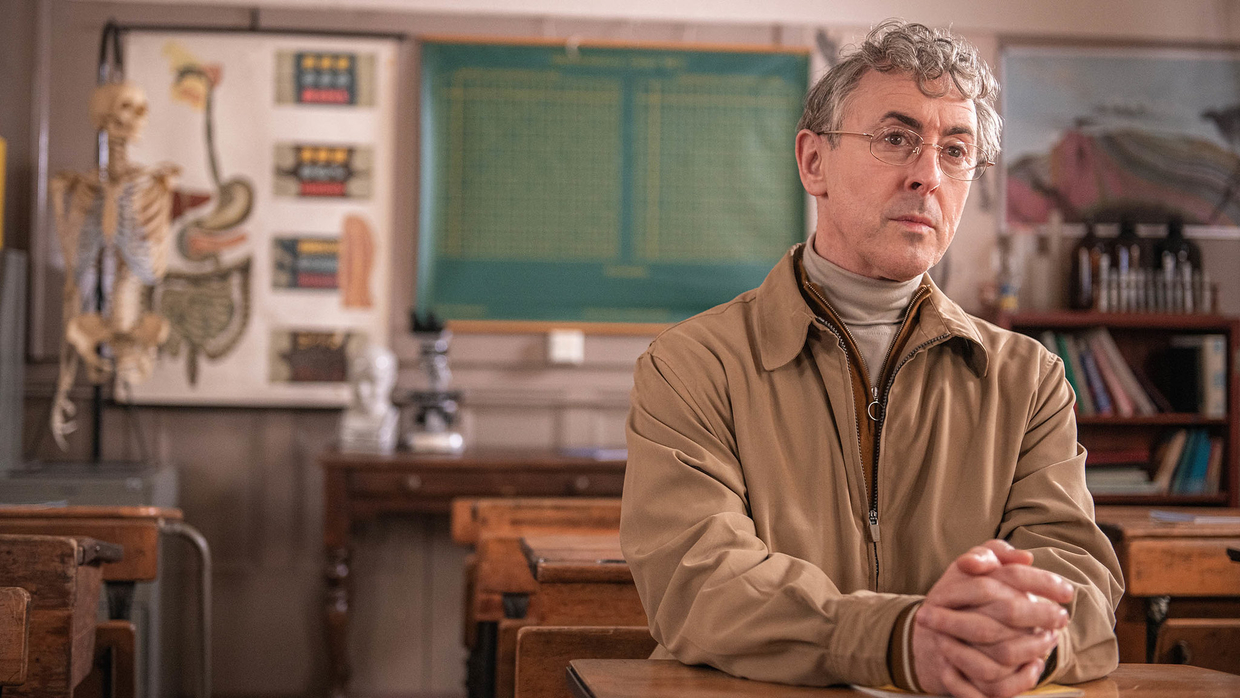 Back to selection
Back to selection
“It Was Hard to Find Settings That Really Evoked the 1990s”: DP George Geddes on My Old School
 Alan Cumming in My Old School by Jono McLeod, an official selection of the 2022 Sundance Film Festival. (photo: Tommy Ga-Ken Wan)
Alan Cumming in My Old School by Jono McLeod, an official selection of the 2022 Sundance Film Festival. (photo: Tommy Ga-Ken Wan) In My Old School, director Jono McLeod returns to his past and reassembles his classmates to tell the strange story of a former classmate, an awkward but fiercely intelligent protector who harbored a secret. Below, cinematographer George Geddes talks about the film’s journey from a documentary with dramatized sequences and then to a heavily rotoscoped feature before settling into a mix of live-action and animation.
Filmmaker: How and why did you wind up being the cinematographer of your film? What were the factors and attributes that led to your being hired for this job?
Geddes: Jono, the director, and I have a few mutual acquaintances, but I can’t quite remember exactly when and how we first met! The original idea was for My Old School to be a documentary featuring parts that were dramatized. My main experience is in shooting both drama and documentary, which fitted in with that plan. The plan changed as we worked on the project, but I believe that broad experience of drama and documentary still stood me in good stead.
Filmmaker: What were your artistic goals on this film, and how did you realize them? How did you want your cinematography to enhance the film’s storytelling and treatment of its characters?
Geddes: The original concept was for the film to include drama elements. One of the early ideas was to have the real characters possibly interacting with actors who were playing younger versions of themselves. But due to a variety of constraints, mainly time and resources, that concept changed as time went by. The interviews that feature in the film are with real people telling their part of this much bigger story. Those interviews took place in an old school setting, and we set out to achieve a warm and almost nostalgic look to those parts of the film.
Filmmaker: Were there any specific influences on your cinematography, whether they be other films, or visual art, of photography, or something else?
Geddes: We talked a lot about other drama documentaries in the early days and how we would bring a playfulness to the dramatic presentations. American Animals was one film that we looked at, but as the plan changed and ideas developed, we looked at different types of animation. Waking Life, the experimental adult animated movie, which is entirely rotoscoped, was another style we considered. The locations were a struggle for us, and it was hard to find settings that really evoked the 1990s, so we looked at shooting those scenes with actors and then enhancing them with rotoscope. While we were considering these different styles and ideas we were still shooting interviews, so we had to keep this in mind as well. Jono then had the idea for animated scenes, which is when MTV’s cartoon Daria caught his eye. This was the option he ultimately decided on, but the film has constantly morphed throughout.”
Filmmaker: What were the biggest challenges posed by production to those goals?
Geddes: Budget was the main challenge. We were trying to do a lot with a tight budget. We tried to be as creative as possible with the resources we had. Time constraints were also a challenge, trying to fit in all of the individual interviews and various parts which told this incredible story.
Filmmaker: What camera did you shoot on? Why did you choose the camera that you did? What lenses did you use?
Geddes: We used the Arri Alexa Mini, which really helped us to create an intimacy and warmth in the interviews, allowing the person who is watching to make eye contact and a personal connection with the interviewee. That was important to us and conveys the relationship and bond that still exists between the old classmates. The zoom gave us a range that worked well at eye view and allowed us to experiment with different shots within the interviews.
Filmmaker: Describe your approach to lighting.
Geddes: For the most part I looked for natural lighting. There are a few sections which are more stylized, but we wanted it to feel as real as possible.
Filmmaker: What was the most difficult scene to realize and why? And how did you do it?
Geddes: There are a few scenes in the movie involving Alan, which are hard to describe without giving too much away, where we had to be creative to make them work.
Filmmaker: Finally, describe the finishing of the film. How much of your look was “baked in” versus realized in the DI?
Geddes: The film involves archival footage and sit-down interviews, so not a huge amount of it was baked in and I lit it as close as it was meant to be, so there wasn’t too much to deal with in the grade.
TECH BOX
Film Title: My Old School
Camera: Arri Alexa Mini
Lenses: Angenieux Optimo 17-80mm T2.2
Lighting: Fresnels and LEDs
